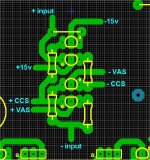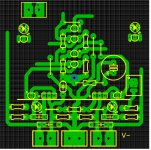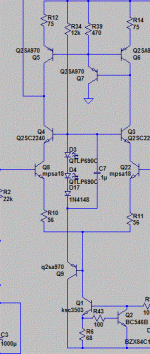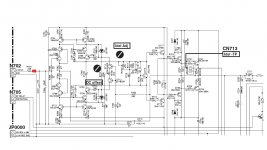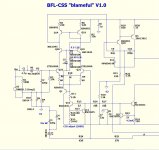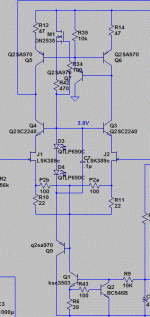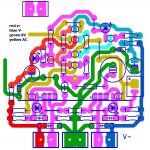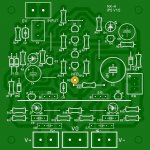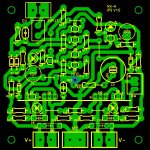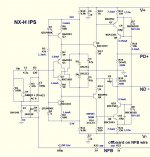Concerted effort ....
After a beer ... I treat the CFA core like a OP-AMP (below).
... I treat the CFA core like a OP-AMP (below).
Real tight... at 20 X 30mm with dead short traces 😀 .
All the "accessories" (CCS/zener/input filter) will be in the leftover space.
I should have enough room for a 35 X 25mm "audiophile cap".
Damn , this is the 4'th re-arrangement. But this is my first of this "alien"
topology.
Don't be too sure about VFA inferiority , Lazy cat ... the "Badger" has
a 100% satisfaction ratio - even a "high end" official review !
PS - I know what is " holding it back" - REDESIGN ....
to avoid IP issues with DIYA (they own the badger) it will NOT be the badger any more !
OS
After a beer
 ... I treat the CFA core like a OP-AMP (below).
... I treat the CFA core like a OP-AMP (below).Real tight... at 20 X 30mm with dead short traces 😀 .
All the "accessories" (CCS/zener/input filter) will be in the leftover space.
I should have enough room for a 35 X 25mm "audiophile cap".
Damn , this is the 4'th re-arrangement. But this is my first of this "alien"
topology.

Don't be too sure about VFA inferiority , Lazy cat ... the "Badger" has
a 100% satisfaction ratio - even a "high end" official review !
PS - I know what is " holding it back" - REDESIGN ....
to avoid IP issues with DIYA (they own the badger) it will NOT be the badger any more !
OS
Attachments
Last edited:
Don't be too sure about VFA inferiority , Lazy cat ... the "Badger" has
a 100% satisfaction ratio - even a "high end" official review !
OS
It's not about VFA, simply there are predispositions in sch that will ruin the sound. A lot of secrets in correlation between sch details and SQ. I am surprised that gurus here on the forum not have a clue, really impressive regarding so many years in the business. 🙄
You've said that you're opened for ideas, comments etc.
It's not about VFA, simply there are predispositions in sch that will ruin the sound. A lot of secrets in correlation between sch details and SQ. I am surprised that gurus here on the forum not have a clue, really impressive regarding so many years in the business. 🙄
You've said that you're opened for ideas, comments etc.
Don't want no "cold war" 😀 . Bring forth those suggestions !
On this forum , just about every flavor of the Linn(blameless) has been created ,
all resulting in rather "neutral amps".
Go to a different topology , like the Sansui "boosted LTP" or the Luxman 120a
you have a different sound. All are better than OEM.
The Hawksford VAS really tickled my ears , brought tears to my eyes 😱 ...
only amp besides the genesis stealth that could.
These differences are very small -
only long term listening to many music types can make for a preference between amps.
PS - Some amps are better at some music types.
... The final push to complete the CFA IPS ... (below)
OS
Attachments
Don't want no "cold war" 😀 . Bring forth those suggestions !
No "cold war" just constructive suggestions. The question has to be answered: Why tube amps are still better than most of the complex and low THD solid state amps? Suggestion: Integrity of the signal, its preservation from the input to the output. To achieve this, signal path should be "clear", meaning no details leakage, no lost on the way. Low THD amps should not be low THD on an account of a loosing signal details, THD meter will show low number anyway but that will not tell you how much of the input signal structure - details are missing. That's why sine signal THD measurement is telling only a little but not enough of the sound quality of a certain amp.
One practical example refering to your VFA sch is input stage's cascode referenced to fixed potential. At this stage the signal path is not "clear", meaning you will loose a lot of signal's details. Anytime you can check the same input stage with or without this cascode in direct A-B test and the difference is enormous in a favour to sch without cascode.
No "cold war" just constructive suggestions. The question has to be answered: Why tube amps are still better than most of the complex and low THD solid state amps? Suggestion: Integrity of the signal, its preservation from the input to the output. To achieve this, signal path should be "clear", meaning no details leakage, no lost on the way. Low THD amps should not be low THD on an account of a loosing signal details, THD meter will show low number anyway but that will not tell you how much of the input signal structure - details are missing. That's why sine signal THD measurement is telling only a little but not enough of the sound quality of a certain amp.
One practical example refering to your VFA sch is input stage's cascode referenced to fixed potential. At this stage the signal path is not "clear", meaning you will loose a lot of signal's details. Anytime you can check the same input stage with or without this cascode in direct A-B test and the difference is enormous in a favour to sch without cascode.
Ahh , the cat has spoken ...
I designed this ability into the "Badger" , the C-R jumper (option) can reference
the cascode to the "virtual CCS ground"(no zener). This is the "luxman way" as described in the build guide.
Some have built it this way , some have not.
My redesign will incorporate this method with a current source at each
rail.
As far as "enormous" , I don't know. Subtle would be more appropriate.
PS - I've done this modular thing before - had blameless in 3 flavors ( no cascode , cascode/bootstrapped vas)
every combination possible.
OS
Last edited:
Is this better way to reference cascode?
Yes , that is more advanced than the Badger "luxman way" (luxman uses crude
resistor divider - 22k+68k). 🙂
I tried that, too. People said I had a "LED fetish" ... I do ! (All those E-waste
Xmas lights)
PS - A wilson CM is better than that enhanced widlar.
OS
Last edited:
Nice trick dadod!
Another one is to use mosfets. You can then use a simple R divider with C filter. Take a look at PMA's design on the JC thread where he used it in a practical 150 W amp.
Another one is to use mosfets. You can then use a simple R divider with C filter. Take a look at PMA's design on the JC thread where he used it in a practical 150 W amp.
Nice trick dadod!
Another one is to use mosfets. You can then use a simple R divider with C filter. Take a look at PMA's design on the JC thread where he used it in a practical 150 W amp.
I know abouth JC design, he is repeating his old desing all the time, nothing new in that.
Cascodes only work where you have to throw charge like modulating a signal over a resistor, when you look into a current mirror my expirence is that a cascode is not of benefit. But quite a big benefit if you have resistors to rail.
Is this better way to reference cascode?
Yes it is ... quite elegant , as well.
Follower referencing the CCS , does not affect the CCS like the "luxman way".
And ... simple enough to add to DIYA's "badger" as well 🙂 .
PS - Satifies my "LED fetish" as well ... 😀 All good , thanks Dado.
OS
Attachments
Pioneer A-A9-J
THAT is a neat little IPS/VAS combo , Apex.
Everything runs at the same current (2-3ma).
I will try a BJT equivalant - very interesting CFA ... thanks.
OS
For an even better cascode load it with a ccs then your current through the V setting LEDs are not changing with the signal
For an even better cascode load it with a ccs then your current through the V setting LEDs are not changing with the signal
You mean a positive rail CCS ? right ...
There is a slight V/I modulation at the cascode ... but THD stays the same or
even drops ! My main reason for the cascode ,was both to let the CM see hi-z +
allow for better (and wider selection) of LTP devices.
As I said , this could also be ported to the Badger AND eliminates
a fixed reference to ground .
OS
I know abouth JC design, he is repeating his old desing all the time, nothing new in that.
Yes, overall design is unchanged for about 25 years. But I am happy to use clever tricks when I see them.
(I am not a believer in the JFET sound or folded cascode . . . )
You mean a positive rail CCS ? right ...
There is a slight V/I modulation at the cascode ... but THD stays the same or
even drops ! My main reason for the cascode ,was both to let the CM see hi-z +
allow for better (and wider selection) of LTP devices.
As I said , this could also be ported to the Badger AND eliminates
a fixed reference to ground .
OS
I showed simplified schematic, this is actually used in my TT amp.
dado
Attachments
Yes, overall design is unchanged for about 25 years. But I am happy to use clever tricks when I see them.
(I am not a believer in the JFET sound or folded cascode . . . )
Maybe I missed that one, could you point to that particular schematic?
dado
Only the input stage left ... 😱 
Alien CFA IS a little harder to layout...
Colored the rails just to see where all the voltages are going ... some longer
traces but only 5 jumpers. The Diamond buffer and rail to rail reference is
what made this harder.
OPS's are mostly all ground referenced and symmetrical.
Below 1-2 is the progress. The input will be easy ... just the signal and
the lifted ground (7 more passives).
OS

Alien CFA IS a little harder to layout...
Colored the rails just to see where all the voltages are going ... some longer
traces but only 5 jumpers. The Diamond buffer and rail to rail reference is
what made this harder.
OPS's are mostly all ground referenced and symmetrical.
Below 1-2 is the progress. The input will be easy ... just the signal and
the lifted ground (7 more passives).
OS
Attachments
- Home
- Amplifiers
- Solid State
- Slewmaster - CFA vs. VFA "Rumble"
